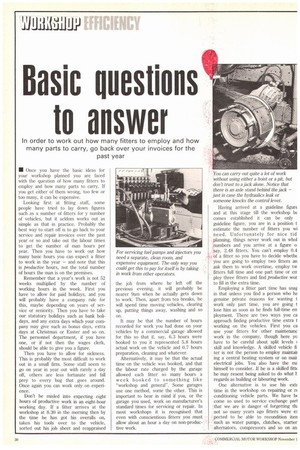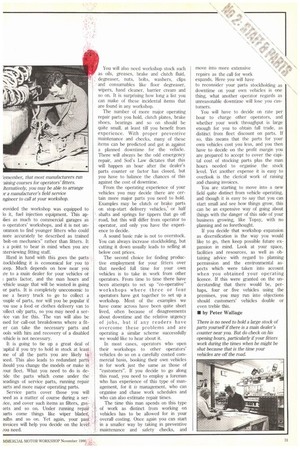Basic Questions to answer
Page 114

Page 115

If you've noticed an error in this article please click here to report it so we can fix it.
In order to work out how many fitters to employ and how many parts to carry, go back over your invoices for the past year
• Once you have the basic ideas for your workshop planned you are faced with the question of how many fitters to employ and how many parts to carry. If you get either of them wrong, too few or too many, it can be expensive.
Looking first at fitting staff, some people have tried to lay down figures such as x number of fitters for y number of vehicles, but it seldom works out as simple as that in practice. Probably the best way to start off is to go back to your service and repair invoices over the past year or so and take out the labour times to get the number of man hours per year. Then you have to work out how many basic hours you can expect a fitter to work in the year — and note that this is productive hours, not the total number of hours the man is on the premises.
Remember that a year's work is not 52 weeks multiplied by the number of working hours in the week. First you have to allow for paid holidays, and you will probably have a company rule for this, maybe depending on years of service or seniority. Then you have to take our statutory holidays such as bank holidays, and any extra days which your company may give such as bonus days, extra days at Christmas or Easter and so on. The personnel department, if you have one, or if not then the wages clerk, should be able to give you a figure.
Then you have to allow for sickness. This is probably the most difficult to work Out in a small firm. Some staff seem to go on year in year out with rarely a day off, others are less fortunate and fall prey to every bug that goes around. Once again you can work only on experience.
Don't be misled into expecting eight hours of productive work in an eight-hour working day. If a fitter arrives at the workshop at 8.30 in the morning then by the time he has got his overalls on, taken his tools over to the vehicle, sorted out his job sheet and reappraised the job from where he left off the previous evening, it will probably be nearer 9am when he actually gets down to work. Then, apart from tea breaks, he will spend time moving vehicles, clearing up, putting things away, washing and so on.
It may be that the number of hours recorded for work you had done on your vehicles by a commercial garage allowed for this so that if, say, 6.3 hours were booked to you it represented 5.8 hours actual work on the vehicle and 0.7 hours preparation, cleaning and whatever.
Alternatively, it may be that the actual time on the vehicle was booked, and that the labour rate charged by the garage allowed each fitter so many hours a week booked to something like "workshop and general". Some garages use one method, some the other. This is important to bear in mind if you, or the garage you used, work on manufacturer's standard times for servicing or repair. In most workshops it is recognised that even with conscientious fitters you must allow about an hour a day on non-productive work.
Having arrived at a guideline figure and at this stage till the workshop be comes established it can be only guideline figure, you are in a position t estimate the number of fitters you wi need. Unfortunately for nice tid planning, things never work out in whol numbers and you arrive at a figure o: say, 2.48 fitters. You can't employ 0.4 of a fitter so you have to decide whethe you are going to employ two fitters an ask them to work overtime, employ tw fitters full time and one part time or err ploy three fitters and find productive wor to fill in the extra time.
Employing a fitter part time has snag in that unless you find a person who ha genuine private reasons for wanting t work only part time, you are going t lose him as soon as he finds full-time en ployment. There are two ways you ca approach finding productive time extra t working on the vehicles. First you ca use your fitters for other maintenanc work in the company, though here ye have to be careful about split levels skill and knowledge. A skilled vehicle fl ter is not the person to employ maintah ing a central heating system or on mair electrical jobs. You also have the nuhimself to consider. If he is a skilled fitt( he may resent being asked to do what t regards as building or labouring work.
One alternative is to use his exti time in the workshop on repairing or r( conditioning vehicle parts. We have la( come so used to service exchange panl .that we are in danger of forgetting thi not so many years ago fitters were el pected to be able to recondition iten such as water pumps, clutches, starter • alternators, compressors and so on an
Irovided the workshop was equipped to lo it, fuel injection equipment. This ap.dies as much to commercial garages as o operators' workshops, and it is not un:ommon to find younger fitters who could nore accurately be described as trained 'bolt-on mechanics" rather than fitters. It s a point to bear in mind when you are nterviewing fitting staff.
Hand in hand with this goes the parts rockholding it is economical for you to ;eep. Much depends on how near you re to a main dealer for your vehicles or L parts factor, and the man hours and Thiele usage that will be wasted in going or parts. It is completely uneconomic to ise a heavy truck to go to collect a :ouple of parts, nor will you be popular if rou use a food or clothes delivery van to :ollect oily parts, so you may need a serrice van for this. The van will also be ised for call-out breakdowns where a fiter can take the necessary parts and ools with him and recovery of a disabled rehicle is not necessary.
It is going to tie up a great deal of apital if you try to hold in stock at least me of all the parts you are likely tu ieed. This also leads to redundant parts thould you change the models or make in four fleet. What you need to do is deide the parts which come under the leadings of service parts, running repair )arts and more major operating parts.
Service parts cover those you will teed as a matter of course during a serrice, and cover such items as filters, gas"tets and so on. Under running repaii• )arts come things like wiper blades, )ulbs and so on. Yet again, your past nvoices will help you decide on the level rou need.
You will also need workshop stock such as oils, greases, brake and clutch fluid, degreaser, nuts, bolts, washers, clips and consumables like floor degreaser, wipers, hand cleaner, barrier cream and so on. It is surprising how long a list you can make of these incidental items that are found in any workshop.
The number of more major operating repair parts you hold, clutch plates, brake shoes, bearings and so on should be quite small, at least till you benefit from experience. With proper preventive maintenance and checks, many of these items can be predicted and got in against a planned downtime for the vehicle. There will always be the odd emergency repair, and Sod's Law dictates that this will happen an hour after the dealer's parts counter or factor has closed, but you have to balance the chances of this against the cost of downtime.
From the operating experience of your vehicles you may decide there are certain more major parts you need to hold.
Examples may be clutch or brake parts on stop-start delivery vehicles,' or half shafts and springs for tippers that go off road, but this will differ from operator to operator, and only you have the experience to decide.
A sound basic rule is not to overstock. You can always increase stockholding, but cutting it down usually leads to selling at below cost prices.
The second choice for finding productive employment for your fitters over that needed full time for your own vehicles is to take in work from other operators. From time to time there have been attempts to set up "co-operative" workshops where three or four operators have got together to set up a workshop. Most of the examples we have come across have been quite short lived, often because of disagreements about downtime and the relative urgency of jobs, but if any readers have overcome these problems and are operating a similar scheme successfully we would like to hear about it.
In most cases, operators who open their workshops to other operators' vehicles do so on a carefully costed com mercial basis, booking their own vehicles in for work just the same as those of customers". If you decide to go along this road, you need to employ a foreman who has experience of this type of management, for it is management, who can organise and chase work schedules and who can also estimate repair times.
The time this man spends on this type of work as distinct from working on vehicles has to be allowed for in your overall costing. Once again you can start in a smaller way by taking in preventive maintenance and safety checks, and
move into more extensive repairs as the call for work expands. Here you will have to reconsider your parts stockholding as downtime on your own vehicles is one thing, what another operator regards as unreasonable downtime will lose you customers.
You will have to decide on rate per hour to charge other operators, and whether your work throughput is large enough for you to obtain full trade, as distinct from fleet discount on parts. If so, this means that the parts for your own vehicles cost you less, and you then have to decide on the profit margin you are prepared to accept to cover the capital cost of stocking parts plus the man hours needed to organise the stock level. Yet another expense it is easy to overlook is the clerical work of raising and chasing invoices.
You are starting to move into a new field quite distinct from vehicle operating, and though it is easy to say that you can start small and see how things grow, this can be an expensive way of going about things with the danger of this side of your business growing, like Topsy, with no planning and no forethought.
If you decide that workshop expansion as diversification is the way you would like to go, then keep possible future expansion in mind. Look at your space, facilities and resources, as well as obtaining advice with regard to planning permission and the environmental aspects which were taken into account when you obtained your operating licence. If this were granted on the understanding that there would be, perhaps, four or five vehicles using the premises, you may run into objections should customers' vehicles double or even treble this.
























































































































